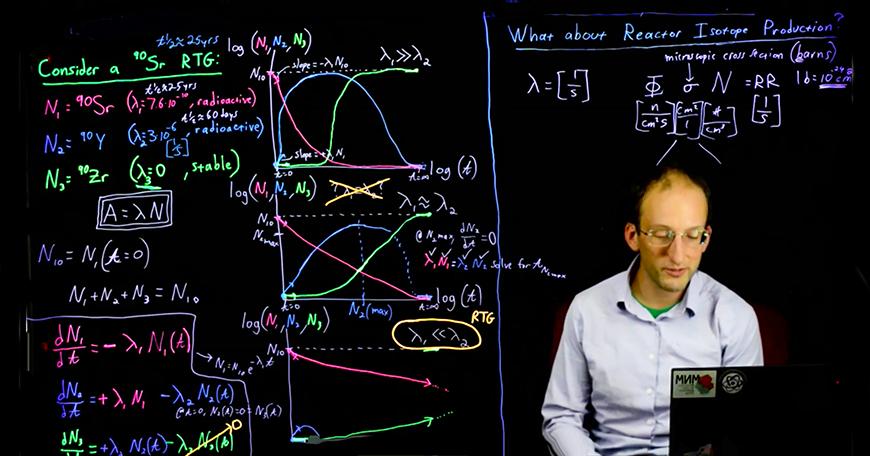When non-experts learn new concepts, it is more effective for them to study step-by-step solutions to solved problems (worked examples) than to attempt solving problems. Worked examples are effective only when learners self-explain the solutions and when multiple, varied worked examples of the same concept are provided. Worked examples are most effective for non-experts (i.e. most of our students most of the time). Experts benefit more from attempting to solve problems than from studying worked examples.
- Provide learners fully worked examples and require them to self-explain solutions through asking students follow-up questions (ex: ‘Why was this strategy used?’, ‘What principle is being applied and why?’), annotating solutions, identifying an error in a solution or asking students to compare solutions of two contrasting examples.
- Consider using Lightboard to work through example problems and uploading the video to Panotpo, where you can then embed checkpoint questions that engage students further with the solution process. A digital whiteboard tool like Explain Everything would also allow for working through, annotating, and explaining the steps of a problem in a visual way.
- As learners become more expert with a concept, fade support by asking them to solve more and more steps within a problem.
- Think about using Gradescope, which makes it easy to create and update rubrics for problems, where you can change the elements you grade students on as you fade support on certain problem types. For instances where students work through questions or problems on Piazza, an instructor looking to fade support can still give quick feedback to students by endorsing a student’s post (i.e., mark as “good”).
18.02 Multivariable Calculus | Denis Auroux:
Worked examples are used extensively in 18.02. Most units in the course contain recitation videos, which provide step-by-step guidance for solving problems, as well as a large number of written worked examples. In 18.02, students are encouraged to watch the recitation videos and study multiple worked examples. To reinforce self-explanations, which are crucial to obtain the worked example effect, instructors should intersperse a worked example recitation video or class demonstration with questions to get students to think about how a given problem is being solved.
22.01 Nuclear Sciences & Engineering | Michael Short:
Prof. Michael Short used a Lightboard to teach synchronously over Zoom, which afforded him the ability to work through and explain problems while facing his virtual audience. Read more about Prof. Short’s use of Lightboard here.

Key resource:
- Renkl, A. (2014). Learning from worked examples: How to prepare students for meaningful problem solving. In V. A. Benassi, C. E. Overson, & C. M. Hakala (Eds.). Applying science of learning in education: Infusing psychological science into the curriculum. HTTP (downloaded PDF available)
Additional:
- Chi, M., Bassok, M., Lewis, M. W., Reimann, P., & Glaser, R. (1989). Self-explanations: How students study and use examples in learning to solve problems. Cognitive Science, 13(2), 145–182. DOI
- Cooper, G., & Sweller, J. (1987). Effects of schema acquisition and rule automation on mathematical problem-solving transfer. Journal of Educational Psychology, 79(4), 347–362. DOI
- Kalyuga, S., Chandler, P., Tuovinen, J., & Sweller, J. (2001). When problem solving is superior to studying worked examples. Journal of Educational Psychology, 93(3), 579–588. DOI
- Kalyuga, S., & Renkl, A. (2010). Expertise reversal effect and its instructional implications: Introduction to the special issue. Instructional Science, 38(3), 209–215. DOI
- Paas, F., & Van Merriënboer, J. (1994). Variability of worked examples and transfer of geometrical problem-solving skills: A cognitive-load approach. Journal of Educational Psychology, 86(1), 122–133. DOI
- Renkl, A. (2014). Toward an instructionally oriented theory of example‐based learning. Cognitive Science, 38(1), 1–37. DOI
- Salden, R. J. C. M., Aleven, V. A. W. M. M., Renkl, A., & Schwonke, R. (2009). Worked examples and tutored problem solving: redundant or synergistic forms of support? Topics in Cognitive Science, 1(1), 203–213. DOI
- Schworm, S., & Renkl, A. (2007). Learning argumentation skills through the use of prompts for self-explaining examples. Journal of Educational Psychology, 99(2), 285–296. DOI
- Salden, R. J. C. M., Koedinger, K. R., Renkl, A., Aleven, V., & McLaren, B. M. (2010). Accounting for beneficial effects of worked examples in tutored problem solving. Educational Psychology Review, 22(4), 379–392. DOI
- Schwonke, R., Renkl, A., Krieg, C., Wittwer, J., Aleven, V., & Salden, R. (2009). The worked-example effect: Not an artifact of lousy control conditions. Computers in Human Behavior, 25(2), 258–266. DOI
- Schworm, S., & Renkl, A. (2007). Learning argumentation skills through the use of prompts for self-explaining examples. Journal of Educational Psychology, 99(2), 285–296. DOI
- Sweller, J., & Cooper, G. A. (1985). The use of worked examples as a substitute for problem solving in learning algebra. Cognition and Instruction, 2(1), 59–89. DOI

